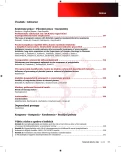Stability of coagulation factors in thawed plasma
Authors:
M. Bohoněk 1; V. Mašková 1; E. Sládková 1; I. Hrachovinová 2; M. Petráš 3
Authors‘ workplace:
Oddělení hematologie a krevní transfuze, Ústřední vojenská nemocnice – Vojenská fakultní nemocnice Praha
1; Laboratoř pro poruchy hemostázy, Ústav hematologie a krevní transfuze Praha
2; 2. lékařská fakulta Univerzity Karlovy v Praze
3
Published in:
Transfuze Hematol. dnes,19, 2013, No. 4, p. 229-239.
Category:
Comprehensive Reports, Original Papers, Case Reports
Overview
Massive blood transfusion protocol requires having lots of blood products handy as soon as possible. Thawing of FFP costs time, therefore it is desirable to have stock of thawed plasma in hospital emergency room. The aim of study is evaluation of quality of fresh frozen plasma after thawing and during following 5day storage at 2–6°C for use in handy storage. 10 units of FFP various blood groups stored at -25°C were randomly selected and thawed. Samples were kept at 2–6°C for 5 days and tested for various coagulation factors each day during storage. Measured values were analysed using the Wilcoxon matched-pairs test and Friedman Test (nonparametric repeated measures ANOVA). All tests were two-tailed with the level of significance set at 0.05. At most of studied parameters were detected gradual decreases of levels. At Protein S and F V, there was approx. 10% decrease from 3rd day, at serine proteases (F II, F VII and F X) there was approx. 20% decrease up until 4th day. Significant activity decrease of 42.6% from 2nd day was detected at F VIII; in following days, activity was stable. All parameters in thawed FFP stored at 2–6°C for 5 days display sufficient activity for clinical use, but it is preferable that they are used within first 24 hours.
Key words:
fresh frozen plasma, liquid plasma, massive transfusion
Sources
1. Pacasová R. Výroba transfuzních přípravků, Tesařová E. Hemoterapie. In: Penka M, Tesařová E, et al. Hematologie a transfuzní lékařství II. I. vyd. Praha, Grada, 2012; 95-128, 131-172
2. Guide to the Preparation, Use and Quality Assurance of Blood Components, Recommentation No R(95) 15, 17th Ed., Council of Europe.
3. Řeháček V, Turek P. Transfuzní přípravky, Řeháček V. Indikace podání transfuzních přípravků, Bohoněk M. Masivní transfuze. In: Řeháček V, et al. Transfuzní lékařství., 1. vyd. Praha, Grada, 2013; 44, 90-91, 92-94
4. Rossaint R, et al. Management of bleeding following major trauma: an updated European guideline. Critical Care 2010; 14: R52
5. Murthi SB, Dutton RP, Edelman BB, Scalea TM, Hess JR. Transfusion medicine in trauma patients. Expert Rev Hematol 2008 October; 1(1): 99–109.
6. Hess JR. Blood and Coagulation Support in Trauma Care. Hematology 2007; 187-191.
7. Hess JR, Holcomb JB, Hoyt DB. Damage Control Resuscitation: The Need for Specific Blood Products to Treat the Coagulopathy of Trauma. Transfusion 2006; 46 : 685-686.
8. Lamboo M, Poland DCW, Eikenboom JCJ, et al. Coagulation parameters of thawed fresh-frozen plasma during storage at different temperatures, Transfusion Medicine 2007; 17 : 182-186.
9. Thiele T, Kellner S, Hron G, et al. Storage of thawed plasma for a liquid plasma bank: impact of temperature and methylene blue pathogen inactivation, Transfusion 2012; 52(3): 529-36.
10. Thawed Plasma Components: A Framework for Preparation, Storage and Use, Australian &New Zealand Society of Blood Transfusion Ltd., 1st. edition, April 2009.
11. Release of Plasma Component Circulars of Information – Change in Storage of Thawed Plasma from 24 Hours to 120 Hours (5 Days), Customer Letter # 2011-22, Canadian Blood Services, 2011-08-15.
12. Circular of information for the use of human blood and blood components by AABB ARC, America’s Blood Centers, and the Armed Services Blood Program; as of Oct. 21, 2009: http://www.aabb.org/resources/bct/pages/aabb_coi.aspx.
13. Lelkens CC, Koning JG, de Kort B, Floot IB, Noorman F. Experiences with frozen blood products in the Netherlands military, Transf Apher Sci., 2006 Jun; 34(3):289-98, Epub 2006 Jul 3.
14. Downes KA, Wilson E, Yomtovian R, Sarode R. Serial measurement of clotting factors in thawed plasma stored for 5 days. Transfusion 2001 Apr; 41(4): 570.
15. Buchta C, Felfernig M, Höcker P, et al. Stability of coagulation factors in thawed, solvent/detergent-treated plasma during storage at 4 degrees C for 6 days. Vox Sang 2004 Oct; 87(3): 182-6.
16. Sidhu RS, Le T, Brimhall B, Thompson H. Study of coagulation factor activities in apheresed thawed fresh frozen plasma at 1-6 degrees C for five days. J Clin Apher 2006 Dec; 21(4): 224-6.
17. Boström F, Sjödahl M, Wehlin L, Egberg N, Lundahl J. Coagulation parameters in apheresis and leukodepleted whole-blood plasma during storage. Transfusion 2007 Mar; 47(3): 460-3.
18. Smith JF, Ness PM, Moroff G, Luban NL. Retention of coagulation factors in plasma frozen after extended holding at 1-6 degrees C. Vox Sang 2000; 78(1): 28-30.
Labels
Haematology Internal medicine Clinical oncologyArticle was published in
Transfusion and Haematology Today

2013 Issue 4
Most read in this issue
- Phlebotomy and therapeutic apheresis in the treatment of polyglobulia
- Antithrombin
- Stability of coagulation factors in thawed plasma
- Blood cell storage lesion
